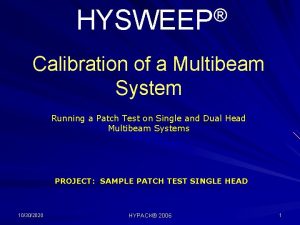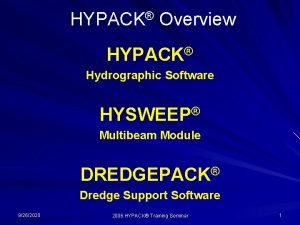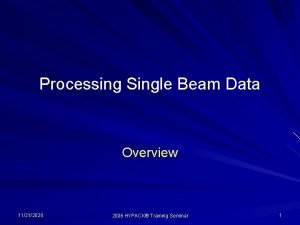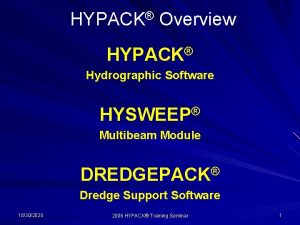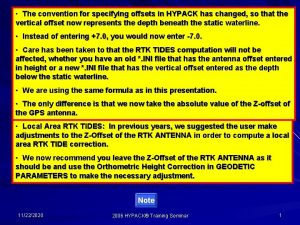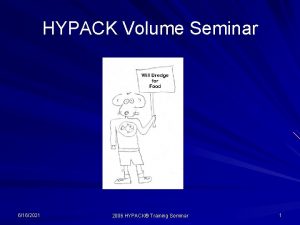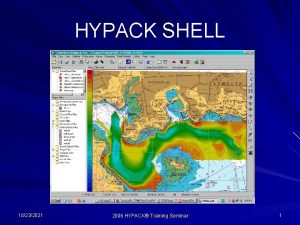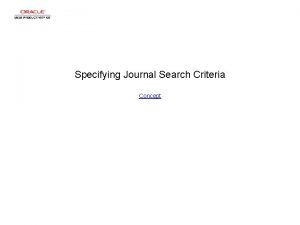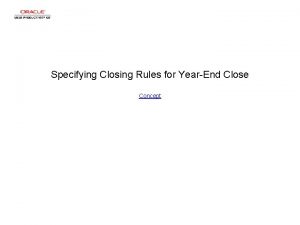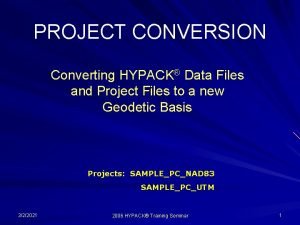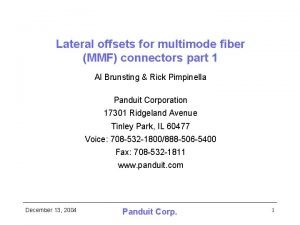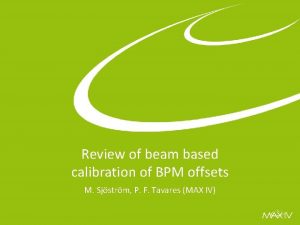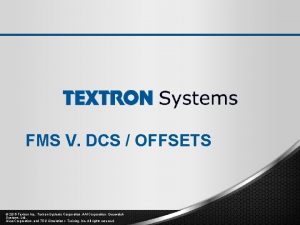The convention for specifying offsets in HYPACK has






























- Slides: 30

• The convention for specifying offsets in HYPACK has changed, so that the vertical offset now represents the depth beneath the static waterline. RTK Tides • Instead of entering +7. 0, you would now enter -7. 0. • Care has been taken to that the RTK TIDES computation will not be affected, whether you have an old *. INI file that has the antenna offset entered in height or a new *. INI file that has the vertical offset entered as the depth below the static waterline. RTK Tide Theory • We are using the same formula as in this presentation. • The only difference is that we now take the absolute value of the Z-offset of the GPS antenna. Using RTK GPS for Real Time • Local Area RTK TIDES: In. Level previous years, we suggested the user make Water Corrections adjustments to the Z-Offset of the RTK ANTENNA in order to compute a local area RTK TIDE correction. • We now recommend you leave the Z-Offset of the RTK ANTENNA as it should be and use the Orthometric Height Correction in GEODETIC PARAMETERS to make the necessary adjustment. Note 6/17/2021 2006 HYPACK® Training Seminar 1

Conventional Tides CS = B + D + T 1 CS = Chart Sounding B = Depth with echosounder calibrated to Vertical Boat Reference (static waterline in this drawing). T 1 = Conventional Tide Correction (Negative when Waterline is above Chart Datum). D = Dynamic Draft. Depth of Vertical Boat Reference Below Waterline. 6/17/2021 2006 HYPACK® Training Seminar 2

RTK Basics CS = B + D + T 2 Where: T 2 = N - K – A + |H| – D T 2 = RTK Tide Correction (Negative when Waterline is above Chart Datum) K = Height of Geoid above Chart Datum N = Height of Geoid above Ellipsoid Reference A = Height of RTK Antenna above Reference Ellipsoid H = Vertical Offset of RTK Antenna Beneath Static Water Line D = Depth of Boat Reference Below Static Waterline 6/17/2021 2006 HYPACK® Training Seminar T 2 3

Where All This Stuff Comes From Item Description Source A Height of RTK Antenna Above the Reference Ellipsoid RTK GPS Update B Depth from Echosounder Calibrated to Vertical Boat Reference (Static Waterline) Echosounder CS Chart Sounding Computed; CS = B’ + D + T 1 B’ = Sound Velocity Corrected Depth D Dynamic Draft Correction: Vertical Movement of Boat Reference Relative to Calibration Position (Positive Downward) Draft Table; Pressure Transducer; Manual Entry H Vertical Offset of RTK GPS Antenna Relative to Static Waterline Measured and input as Z-Offset in KINEMATIC. DLL K Height of Geoid Above Chart Datum KTD File Created by the User N Height of Geoid Above Reference Ellipsoid Geoidal Model with Correction. T 1 Conventional Tide Correction Manual Entry, Telemetry Gauge, Predicted Tide, Scaled Tide T 2 RTK Tide Correction Computed by KINEMATIC. DLL T 2 = N - K – A + H - D 6/17/2021 2006 HYPACK® Training Seminar 4

RTK: Some Sample Numbers H = -7 Conventional Surveying RTK Tides T 1 = -10 T 2 = N - K – A + |H| – D T 2 = 9 - 4 – 22 + |-7| – 0 = -10 CS = B + D + T 1 = 30 + (-10) = 20 6/17/2021 CS = B + D + T 2 = 30 + (-10) = 20 2006 HYPACK® Training Seminar 5

RTK: The Tide Rises H = -7 Original Configuration The Tide Rises 5 m T 2 = N - K – A + |H| – D T 2 = 9 - 4 – 22 + |-7| – 0 = -10 T 2 = 9 - 4 – 27 + |-7| – 0= -15 CS = B + D + T 2 = 30 + (-10) = 20 CS = B + D + T 2 = 35 + 0 + (-15) = 20 6/17/2021 2006 HYPACK® Training Seminar 6

RTK: The Draft Changes H = -7 Original Configuration Boat is Displaced 1 m Downward T 2 = N - K– A + |H| – D T 2 = N - K – A + |H| – D T 2 = 9 - 4 – 22 + |-7| – 0 = -10 T 2 = 9 - 4 – 21 + |-7| – 1 = -10 CS = B + D + T 1 = 30 + (-10) = 20 CS = B + D + T 2 = 29 + 1 + (-10) = 20 6/17/2021 2006 HYPACK® Training Seminar 7

RTK: The Draft Changes, But Isn’t Measured Conventional H = -7 RTK Tides H = -7 Conventional Tides RTK Tides T 1 = -10 (from gauge) T 2 = N - K – A + |H| – D T 2 = 9 - 4 – 21 + |-7| – 0 = -9 CS = B + D + T 1 = 29 + 0 + (-10) = 19 CS = B + D + T 2 = 29 + 0 + (-9) = 20 Note: Without measuring the Dynamic Draft Correction, the Chart Sounding from the RTK method is still correct, while the one from the conventional method is in error. 6/17/2021 2006 HYPACK® Training Seminar 8

Determining Height of Reference Ellipsoid Relative to the Chart Datum Our formula for the RTK Tide: – T 2 = N - K – A + |H| – D The term (N - K) is the Height of the Chart Datum Above the Reference Ellipsoid You can determine the value of (N - K) by performing a test at a tidal benchmark. 6/17/2021 2006 HYPACK® Training Seminar 9

Determining (N - K) Set up your RTK GPS Antenna next to the tidal benchmark. H = -4. 0 Observe: H = Height of Antenna Above Waterline A = Height of RTK Antenna Above Reference Ellipsoid T 1 = Observed Tide Correction From our Formula: T 2 = N - K – A + |H| – D -2. 5 = N - K – 7. 1 + |-4. 0| – 0. N - K = 0. 6 6/17/2021 Note that in our test, we cannot separate N and K. We could only do this if we had information from the Geoid Model regarding N. 2006 HYPACK® Training Seminar 10

Movement Between RTK Updates In RTK Tide surveys, we will need an MRU to determine the movement of the RTK Antenna between updates. Method 1: MRU is used to determine movement of antenna between fixed RTK zvalues. Merge Tide Data with Heave. Method 2: RTK z-values are used to determine ‘Normalized Heave Plane’. MRU data is applied directly to this plane. Average Tide Data to Remove Heave. The decision on which method to use is made in SBMAX and MBMAX. 6/17/2021 JPG SBMAX RTK Settings 2006 HYPACK® Training Seminar 11

RTI Tides in a Local Area For a small survey area, treat (N-K) as a constant Set the Orthometric Height Correction in GEODETIC PARAMETERS Equal to (N-K). Note: The only device drivers you should use for computing RTK Tides are the KINEMATIC. DLL or GPS. DLL. 6/17/2021 2006 HYPACK® Training Seminar 12

RTK in a Local Area In a survey over a small area we will assume that (N - K) is a constant. The RTK TIDE has been defined as: T 2 = N - K – A + |H| – D In SURVEY: TIDE = T 2 + OHC Where OHC = Orthometric Height Correction taken from GEODETIC PARAMETERS. For a local area: – Set OHC = N-K – Enter the value in GEODETIC PARAMETERS – OHC should always be entered in meters! – If you are on a foot grid, the final Tide Correction will still be displayed in feet. GEODETIC PARAMETERS JPG 6/17/2021 2006 HYPACK® Training Seminar 13

Local Area Example H = -7 N = 9. K = 4. N-K = 5. 0 In GEODETIC PARAMETERS: – Set OHC = 5. 0 In HARDWARE: – Set Z-Offset of GPS Driver to -7. 0. AVI RTK Local Area 6/17/2021 2006 HYPACK® Training Seminar AVI RTK in SURVEY 14

RTK Tides in a Wide Area using a KTD File When the height of the reference ellipsoid above the chart datum (N-K) is not a constant. PROJECT: SAMPLE RTK TIDES WIDE AREA 6/17/2021 2006 HYPACK® Training Seminar 15

Using RTK Tides in a Large Area We have defined the RTK Tide as: T 2 = N - K - A + |H| - D In a local area, we assume the term (N - K) is a constant. Over a wide area, the vertical location of the Geoid and Ellipsoid relative to the Chart Datum may change. (N - K) is no longer a constant. 6/17/2021 2006 HYPACK® Training Seminar 16

Determining (N – K) We saw how to determine (N-K) by performing a test at a tidal benchmark. H = -8. 0 – (N – K) = T 1 + A – |H| + D – where D = 0 For a large area, we will repeat this test at all available tidal benchmarks around our survey area. 6/17/2021 2006 HYPACK® Training Seminar 17

Wide Area RTK In our large survey area (right), we have performed the test at four tidal benchmarks. The (N - K) values at each site are shown. We will create ‘gridded’ (N – K) values and save them to the KTD file. The KINEMATIC. DLL will interpolate an (N – K) value, based on the vessel’s position relative to the gridded (N – K) values. 6/17/2021 2006 HYPACK® Training Seminar KTD Area 18

Contouring the Area I’ve done a rough contour job on our area to allow me to pick the (N - K) value at each node of our rectangular grid. Note: For metric grids, compute the separation in meters. For foot grids, compute the separation in feet. 6/17/2021 2006 HYPACK® Training Seminar 19

Assigning the Node Values Using the contours, I have determined an (N - K) value for each node. 1. 2. 3. Open the ‘SAMPLE RTK TIDES WIDE AREA’ project. Under the Editors, open the ‘KTD Tide Editor’. Open the Sample. KTD file. 6/17/2021 2006 HYPACK® Training Seminar 20

KTD Tide Editor AVI KTD Editor 6/17/2021 2006 HYPACK® Training Seminar 21

Configuring the KINEMATIC. DLL 1. 2. 3. 4. • 5. Close the KTD Tide Editor. Start the HARDWARE program. Select the Kinematic device. Click on Setup – The Setup is the Same for local area, wide area and geoid model methods! The KINEMATIC. DLL loads any active KTD file it finds in the MAX Project Files area. Now exit HARDWARE and start SURVEY. 6/17/2021 2006 HYPACK® Training Seminar 22

KTD File in SURVEY Click the window to begin AVI At the time of one capture: A = 2. 00 m = 6. 56’ H = 7. 00’ D = 0. 00’ N - K = 3. 85’ Therefore: T 2 = N - K – A + |H| – D T 2 = 3. 85 -6. 56 + |-7. 00| – 0. 00 T 2 = 4. 29’ $GPGGA, 135600, 4606. 800000, N, 08401. 000000, W, 3, 08, 0. 9, 2. 00, M, 0. 00, M, 1, 0000*4 D 6/17/2021 2006 HYPACK® Training Seminar 23

RTK Tides Using a Geoidal Model Using Geoid 99 for ‘N’ Values PROJECT: SAMPLE RTK GEOID MODEL 6/17/2021 2006 HYPACK® Training Seminar 24

Reading a Geoidal Model for RTK Tides The KINEMATIC. DLL and GPS. DLL can read Geoidal Models to determine the N value. HYPACK MAX can work with Geoidal Models from the USA, Canada, UK and France. Open up the ‘SAMPLE RTK GEOID MODEL’ project. 6/17/2021 2006 HYPACK® Training Seminar 25

Where Everything Comes From Formula : T 2 = N - K – A + |H| – D Item Source T 2 RTK Tide: Computed by KINEMATIC. DLL or GPS. DLL. K Height of Geoid Above Chart Datum: KTD File N Height of Geoid Above Reference Ellipsoid: Geoid Model A Height of RTK Antenna Above Reference Ellipsoid: RTK GPS H Vertical Offset of RTK Antenna Below Vertical Boat Reference: Measured D Movement of Vertical Boat Reference: Measured by Sensor or Ignored 6/17/2021 2006 HYPACK® Training Seminar 26

Configuring GEODETIC PARAMETERS Geoid Models can be copied to the HYPACKDatum directory during installation. Once selected, the ‘N’ value will be read from the file. We’ll create a KTD file that contains only ‘- K’ values. The Orthometric Height Correction is entered in meters and is used to adjust the ‘N’ value. – On a foot grid, it will convert it to a foot value. 6/17/2021 2006 HYPACK® Training Seminar AVI Selection of Geoid 27

Setting up the KTD File If you use a geoid model, the KTD file will now provide the Height of the Geoid Above the Chart Datum (- K). You can isolate the values in the test at the tidal benchmark by determining the ‘N’ value from the geoid model at the point of the test. 6/17/2021 2006 HYPACK® Training Seminar 28

Configuring the KINEMATIC. DLL Set the Z-Offset of the GPS to = -7. 00 in the Offsets section. The KTD File is no longer specified in the driver setup. It will load any active KTD file in the project. 6/17/2021 Under Setup, I’ve told it to process GGA messages and to ignore the checksum. 2006 HYPACK® Training Seminar 29

Geoid Model in SURVEY From the Display: T 2 = -5. 90 K = -113. 85 N = -120. 19 From our Offsets: H = 7’ From our RTK GPS: A = 2. 0 m = 6. 56’ T 2 = N - K – A + |H| – D T 2 = -120. 19 – (-113. 85) – 6. 56 + |-7. 00| – 0. 00 T 2 = -5. 90 From SURVEY: 6/17/2021 D=0 2006 HYPACK® Training Seminar 30
 Specifying a purpose for research
Specifying a purpose for research Channel design decisions example
Channel design decisions example Patch test multibeam
Patch test multibeam Hypack 2020 manual
Hypack 2020 manual Hypack manual
Hypack manual Hypack conference
Hypack conference Offsets in plants
Offsets in plants Debatt artikel mall
Debatt artikel mall Kung som dog 1611
Kung som dog 1611 Shivaiter
Shivaiter Tobinskatten för och nackdelar
Tobinskatten för och nackdelar Big brother rösta
Big brother rösta Vad är referatmarkeringar
Vad är referatmarkeringar Vad är hsil
Vad är hsil Shingelfrisyren
Shingelfrisyren Byggprocessen steg för steg
Byggprocessen steg för steg Vätsketryck formel
Vätsketryck formel Förklara densitet för barn
Förklara densitet för barn Elektronik för barn
Elektronik för barn Borra hål för knoppar
Borra hål för knoppar Läkarutlåtande för livränta
Läkarutlåtande för livränta Tack för att ni har lyssnat
Tack för att ni har lyssnat Smärtskolan kunskap för livet
Smärtskolan kunskap för livet Inköpsprocessen steg för steg
Inköpsprocessen steg för steg Fimbrietratt
Fimbrietratt Vad är ett minoritetsspråk
Vad är ett minoritetsspråk Typiska novell drag
Typiska novell drag Delegerande ledarskap
Delegerande ledarskap Humanitr
Humanitr Var finns arvsanlagen
Var finns arvsanlagen Toppslätskivling dos
Toppslätskivling dos


